Exploring traditional Tboli music reveals a rich tapestry beyond the renowned hegelung. Kulintang and agung feature prominently, their entwined melodies narrating myths and seeking spiritual harmony. These instruments, along with traditional Tboli language, play crucial roles in rituals and ceremonies, ensuring cultural continuity. Festivals like Tnalak and Lemlunay showcase these performances, fostering community spirit and pride. Leadership structures, like the role of the Datu, uphold these traditions, blending cultural values with community consensus. Efforts to document and preserve Tboli music face challenges from globalization, yet projects such as the Utom Project and youth engagement programs aim to maintain cultural identity. By exploring further, one gains deeper insights into the cultural significance and preservation of Traditional Tboli music.
Tboli Music Overview
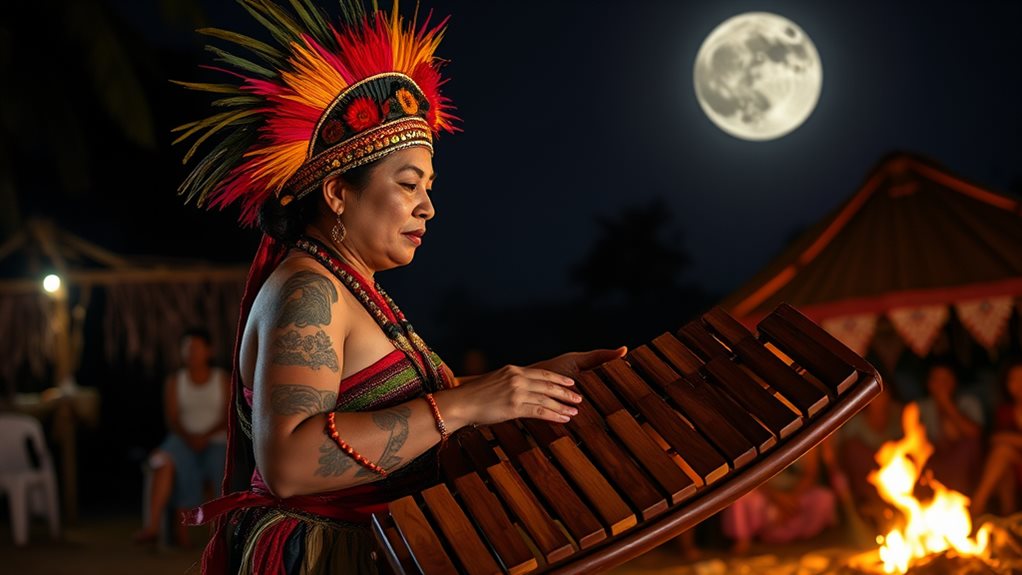
In the context of exploring the rich tapestry of Tboli culture, utom, or Tboli music, emerges as an essential element serving to preserve cultural identity through intricate melodies and rhythms.
You engage with traditional Tboli music through various instruments such as the hegelung, kulintang, and agung, each playing a crucial role in the music's composition. The hegelung, a small two-stringed lute, produces melodies that accompany storytelling and rituals.
Meanwhile, the kulintang, a set of gongs, and the agung, a larger gong, collectively produce rhythmic patterns that underscore the spiritual and ceremonial aspects of Tboli life. Tboli songs frequently convey myths, legends, and spiritual beliefs, echoing the community's deep connection to nature and their ancestors.
Celebrations like Lemlunay and Tnalak prominently feature Tboli music, these festivals serving as platforms for traditional performances that enhance community spirit and cultural pride.
Beyond entertainment, Tboli music is integral to rituals and ceremonies, reinforcing themes of spirituality, ancestral reverence, and overall cultural heritage.
Cultural Identity Through Music
The Tboli people, with a population of around 80,000, employ music as a significant means to express and preserve their cultural identity. This expression is evident in the storytelling medium of utom, which conveys Tboli myths and legends, preserving the community's oral history and cultural practices.
Traditional instruments such as the hegelung (a two-stringed lute) and kulintang (a gong ensemble) are integral to Tboli music, reflecting a deep connection to nature and spirituality. Festivals like Tnalak and Lemlunay highlight music's role in fostering social unity and cultural pride among the Tboli people, showcasing their artistic expressions.
The Tboli language, with its unique seven-vowel system, often interwoven into musical compositions, further reinforces your cultural identity through linguistic expression. Thus, music plays a crucial role in defining and maintaining your cultural roots and traditions.
Spirit and Ritual Music
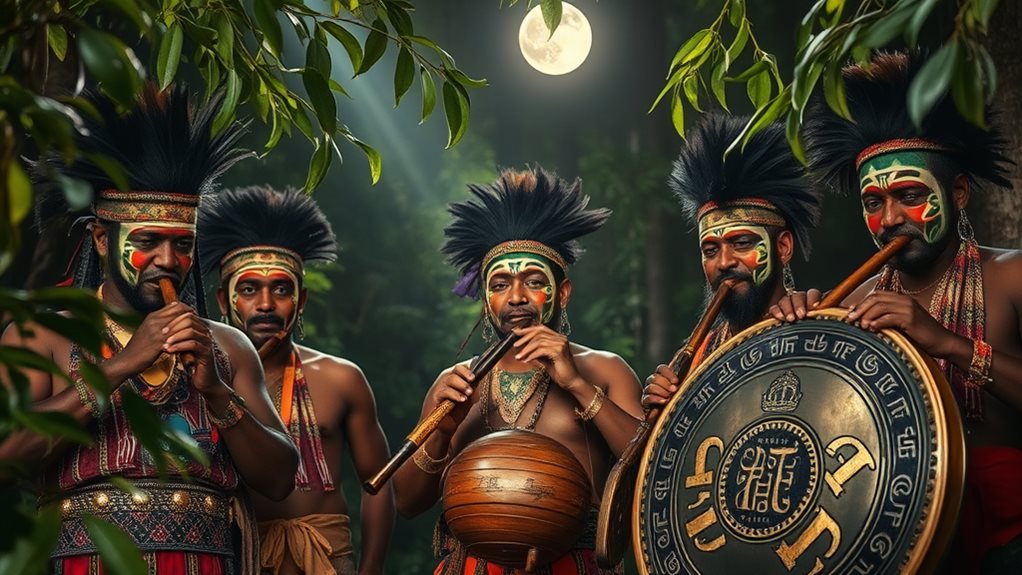
Spirit music weaves through rituals, invoking offerings called densu to appease nature spirits like Dwata and FunKoyu, reflecting deep spiritual beliefs.
Tboli instrumental music is central to these rituals, employing the hegelung and agong to create a Sounding Pantheon of Nature. The hegelung, a two-stringed lute, emits melodic lines that narrate ancestral stories, ensuring cultural continuity and spiritual guidance.
Meanwhile, the agong produces rhythmic patterns that connect participants with the divine, reinforcing communal identity.
Ritual music serves during significant life events to influence the spiritual realm, with melodies tailored for protection, healing, or blessings.
Community participation is essential, as music acts as a medium for collective expression and social cohesion, reinforcing the Tboli's bond with nature and their shared spiritual heritage.
Role of Leadership
Within the Tboli community, where music plays a pivotal role in rituals and spiritual life, leadership holds a position of authority and responsibility.
The Datu, as the tribal leader, is chosen by a council of leaders, tasked with demonstrating strong leadership, communication skills, and a deep understanding of Tboli traditions.
Leadership in the Tboli community is grounded in the Sebila, or Friendship Pact, symbolizing unity and often formalized through a blood compact between families.
The Datu resolves conflicts, presiding over disputes and employing traditional trials for offenses like adultery and theft.
Beyond governance, the Datu acts as a mediator, upholding harmony and cultural integrity among Tboli people.
The leadership structure reflects a blend of traditional practices and community consensus, ensuring decisions align with cultural values.
Social Festivals and Music
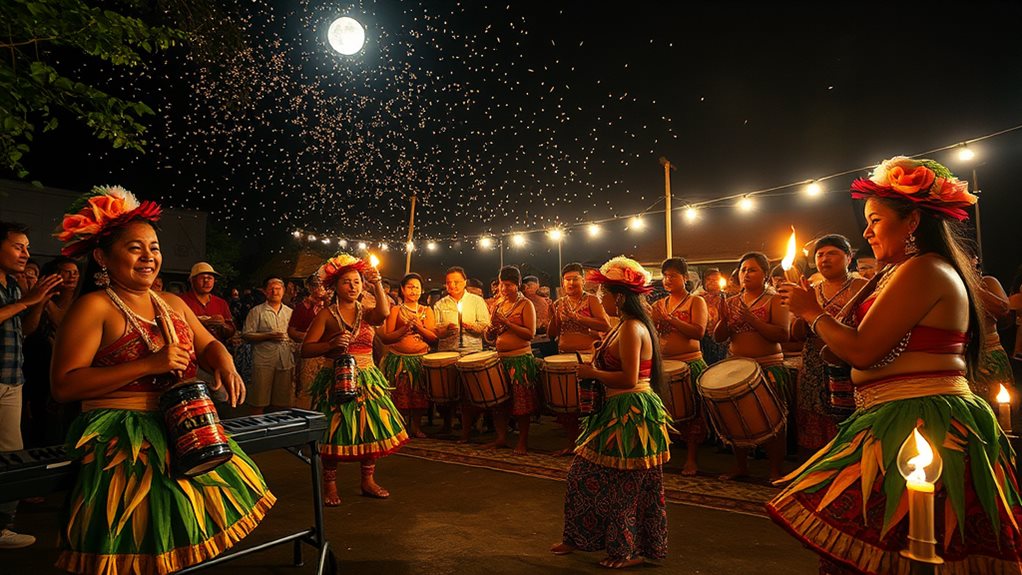
During the month of November, in celebration of Helobung and July's Tnalak, music intertwines with traditional attire and community participation to showcase rich cultural heritage, while in September's Lemlunay, it highlights artistic expressions and fosters unity among Tboli members, attracting both locals and visitors.
Music serves as a central element in these festivals, acting as a storytelling medium that conveys myths and cultural narratives, strengthening communal identity.
Community involvement in festival preparations and performances is crucial, enhancing cultural pride and awareness, and allowing the Tboli to share their traditions.
Each event brings together the Tboli to engage in traditional dances and rituals, reinforcing their cultural heritage through active participation and shared experiences.
Through these social festivals, music not only entertains but also educates, preserving the Tboli culture for future generations.
Instruments and Sounds
Music serves as a focal element in Tboli social festivals, enriching communal identity through storytelling and cultural celebration. You explore a variety of traditional musical instruments, each contributing uniquely to Tboli music.
The hegelung, a two-stringed lute, stands out for its distinct playing technique involving nail usage that enhances expressiveness and creates a tonal quality reflecting cultural narratives. The kulintang, a set of gongs, plays a central role in Tboli music, present in both communal gatherings and formal ceremonies.
Here are details on its elements:
- The kulintang consists of a row of eight graduated gongs, played with wooden mallets to produce complex melodies.
- Bamboo jaws harps (kumbing) add a high-pitched, clear sound, emphasizing nature's resonance in Tboli music.
- Drums, including the agong (a large gong), provide rhythmic depth, supporting the kulintang and other instruments.
- Traditional musical instruments in Tboli music are designed to replicate nature's sounds, embodying spiritual connections of the community.
Dance and Music Integration
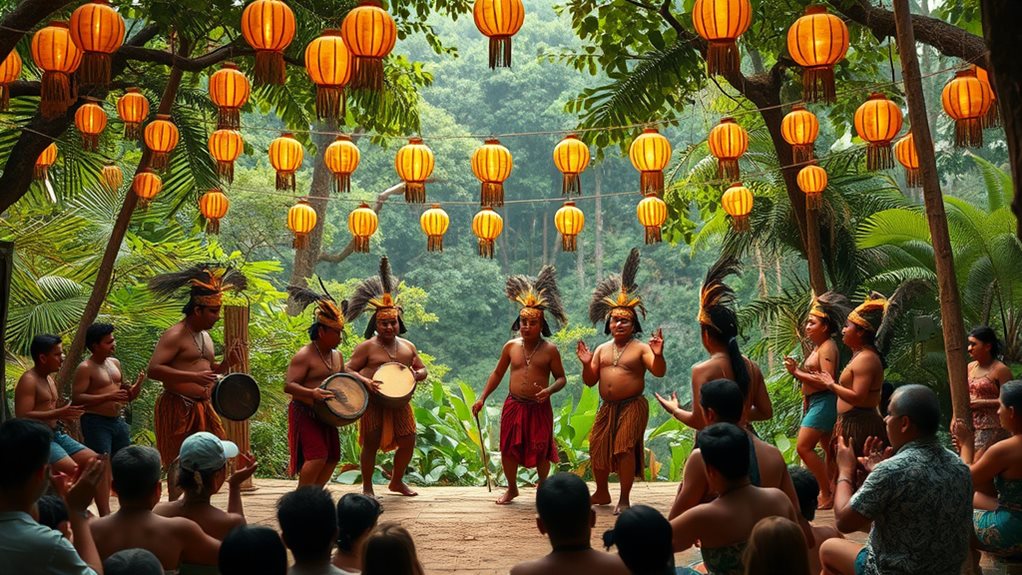
Tboli festivals bring together dance and music for expressive storytelling, reflecting cultural beliefs and strengthening community bonds. This dance and music integration is evident in performances of Tboli dances like Madaltahu, depicting a mythical hero, and Madal soyow, showcasing warriors.
Traditional Tboli music, featuring instruments such as the hegelung and kulintang, accompanies these dances, enhancing the narratives and cultural expressions. Festivals such as Tnalak and Helobung prominently feature this integration, with community members in traditional attire merging rhythmic steps with melodic storytelling.
The interplay between dance and music not only entertains but preserves cultural identity and fosters closer communal ties. Musical rhythms and patterns intricately link to the choreography of Tboli dances, with specific steps and formations designed to complement the musicality of the instruments.
Spiritual Beliefs
Spirituality weaves through the fabric of daily life, centering around the worship of nature spirits such as Dwata, the god of creation, and FunKoyu, the spirit of the forest, with rituals and offerings made to appease them.
In southern Philippines, these beliefs are integral to the Tboli community, influencing various aspects of their culture including their music in the making.
Offerings, known as densu, play a pivotal role, involving gifts of food, tobacco, and other items to maintain harmony with the spirits.
Death is perceived as a transformative journey, where the deceased are guided on a soul boat to the afterlife with specific burial rites to honor them and ensure their passage.
The Tboli maintain a profound connection to nature, valuing herbal knowledge and remedies for illnesses, all stemming from their spiritual beliefs.
Here are key elements of the ritual process:
- Cooking specific foods intended for offerings to the spirits.
- Preparing herbal teas and potions as part of appeasing rituals.
- Selecting sacred locations or temples for ritual ceremonies.
- Invoking the spirit names and requesting protection or blessings.
Healing Practices
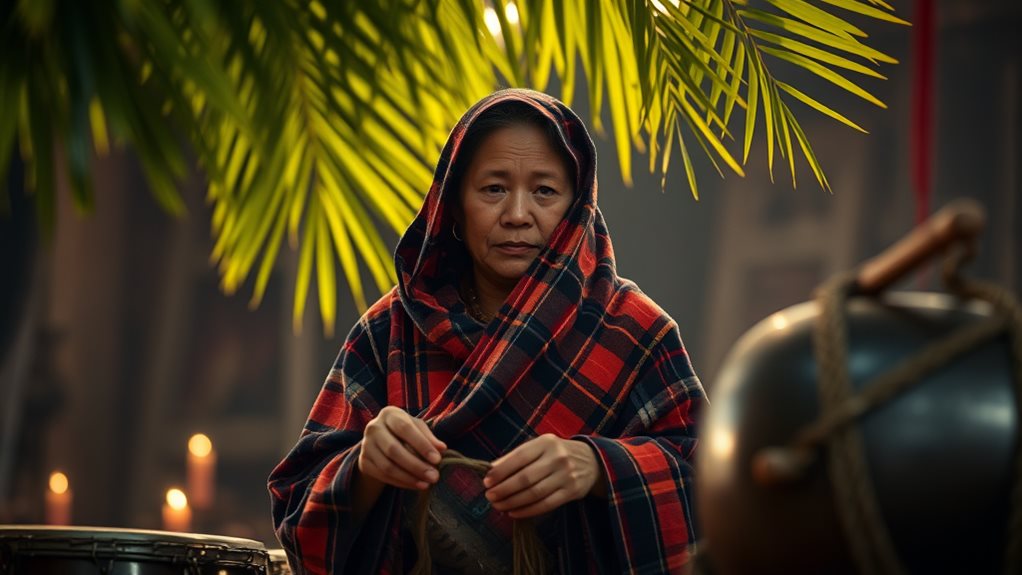
When illnesses arise, often seen as punishments from angry deities, rituals and offerings are conducted by mwanga and mtonbu to appease these spirits and restore health, drawing on traditional herbal remedies that reflect your deep connection to nature and spirituality.
These healers utilize local plants, meticulously documented within your culture, to treat various ailments, showcasing a wealth of traditional knowledge passed down through generations.
The rituals not only address physical ailments but also reinforce cultural beliefs and values, enhancing social harmony and community cohesion.
Music plays a crucial role in these practices; songs and instrumental performances enhance the effectiveness of rituals and connect individuals to the spiritual realm.
Scholars from the Musicological Society have noted the importance of these musical elements, underscoring their integral role in the broader cultural context of the Tboli community in Lake Sebu.
Death and Burial Rituals
In the aftermath of illness and death, seen as a journey in a boat to another realm, rituals and offerings play a pivotal role in honoring the deceased and ensuring a safe passage. The Tboli believe that this spirit journey isn't just a physical transition but a transformation influenced by the life and the manner of death.
Death symbolism is deeply rooted in these beliefs, manifesting in various burial offerings that prepare the soul for the afterlife. These offerings can vary widely depending on whether the deceased is an adult or a child, each stage of life having its own set of rituals and offerings to appease and guide the spirit safely.
For adults, the process involves a series of steps aimed at safeguarding the soul:
- The body is washed and prepared with specific herbs, believed to purify and protect the deceased.
- Additional items, such as clothing and tools, are placed in the grave to assist the spirit in its new realm.
- Offerings of food and drink are provided to nourish the spirit during its journey.
- Finally, musical performances and prayers are conducted to honor the deceased and request favorable guidance.
Respect for the deceased pervades each step, emphasizing the importance of a dignified and spiritually satisfying transition.
These rituals, meticulously enacted, underscore the Tboli's belief in maintaining a harmonious balance with the spirit world.
Woman Shaman Songs
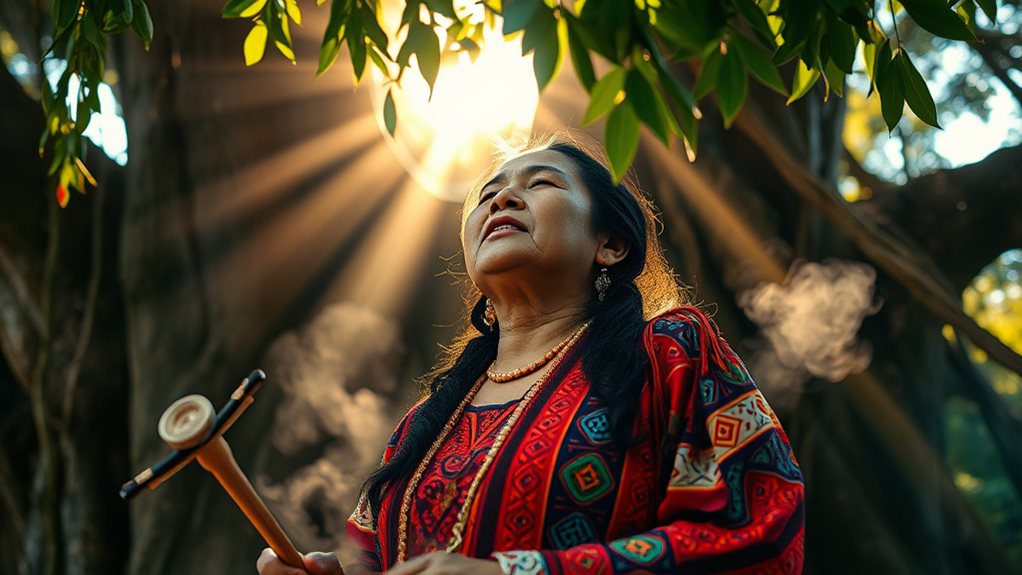
Singing woman shaman songs integrates deeply into the spiritual and healing practices of Tboli culture, performed by female shamans who invoke nature spirits and ancestral guidance.
These songs employ rich shamanic symbolism, reflecting the oral tradition and conveying cultural meanings through variations in storytelling. Distinctive melodic structures characteristic of woman shaman songs often feature low-pitched vocals, rooted in ancestral connections that bind the community to its mythology.
During rituals and festivals, these performances serve both as healing practices and cultural expressions, preserving traditional knowledge.
The documentation and translation of these songs have become crucial for promoting awareness of Tboli culture and ensuring the transmission of ancestral wisdom to future generations.
Musical Connections Regionally
Several musical similarities link the Tboli to other Austronesian cultures, particularly in the use of gong-row ensembles, which mirror Indonesian traditions.
This interconnectedness further manifests through the incorporation of instruments like the kulintang and agung, staples in the southern Philippines and Borneo.
The two-stringed lute, the hegelung, also bridges cultural exchanges across regional borders, emphasizing shared musical practices.
The Tboli's melodic patterns, influenced by their unique seven-vowel language system, resonate with those of other Austronesian languages in the region.
Festivals such as Lemlunay feature collaborative performances that draw upon this shared musical heritage, strengthening regional cultural ties.
Here are the key aspects:
- Use of gong-row ensembles similar to Indonesian traditions
- Incorporation of kulintang and agung from southern Philippines and Borneo
- Presence of two-stringed lute hegelung across regional cultures
- Melodic patterns resonating with other Austronesian languages
Documentation Challenges
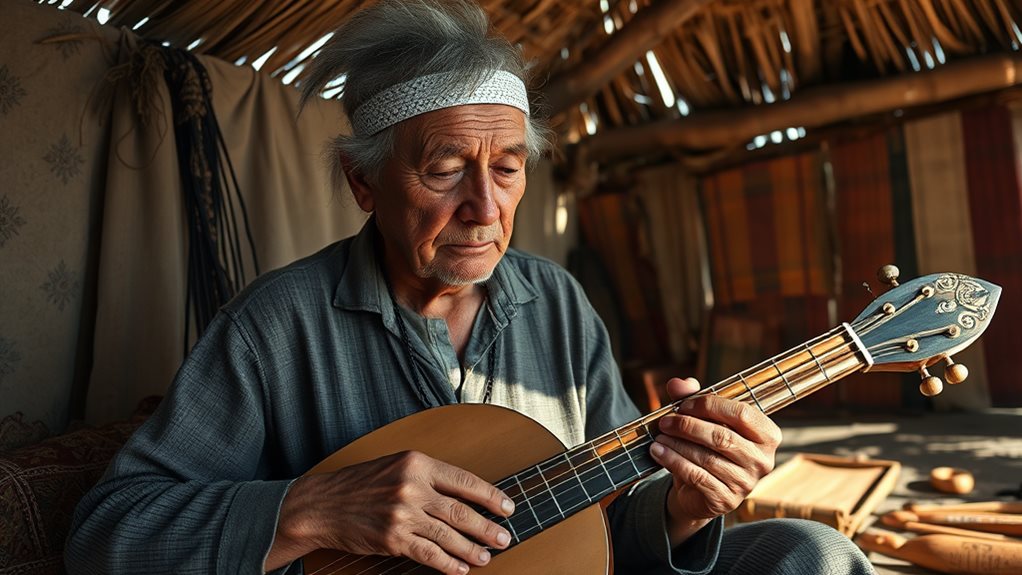
Frequently, the documentation of Tboli traditional music suffers from imprecise descriptions and vernacular names, making it difficult to grasp the full cultural significance of their instruments.
Musical transcription methods often fall short, failing to capture nuances in performance techniques unique to the Tboli.
Oral tradition preservation efforts lag behind, as there are few publishers translating Tboli songs, limiting access to lyrical content and its cultural context.
An album featuring Tboli music provides an atmospheric snapshot but lacks detailed insights into performance practices crucial for a comprehensive cultural significance exploration.
These challenges underscore broader difficulties in documenting indigenous cultures, where oral traditions may be inadequately recorded, risking loss of valuable knowledge over time.
Cultural Preservation Efforts
While documenting Tboli traditional music faces challenges such as imprecise descriptions and limited transcription methods, efforts to preserve their cultural heritage are gaining momentum.
Community involvement plays a central role, with the Utom Project supporting awareness through recordings and live performances that feature traditional instruments. Cultural storytelling is integral, emphasizing oral traditions and local legends within these initiatives.
Youth engagement is crucial for sustainability; programs like Lemlunay and Tnalak engage younger generations, fostering pride in Tboli identity.
Collaborative projects with ethnomusicologists and filmmakers improve preservation by documenting practices and introducing them to broader audiences. Funding from organizations such as The Wallace Alexander Gerbode Foundation aids in these endeavors.
- Recording traditional music and performances
- Raising awareness through artist collaborations
- Educational programs engaging youth
- Documenting practices with ethnomusicologists and filmmakers
Utom Music Composition
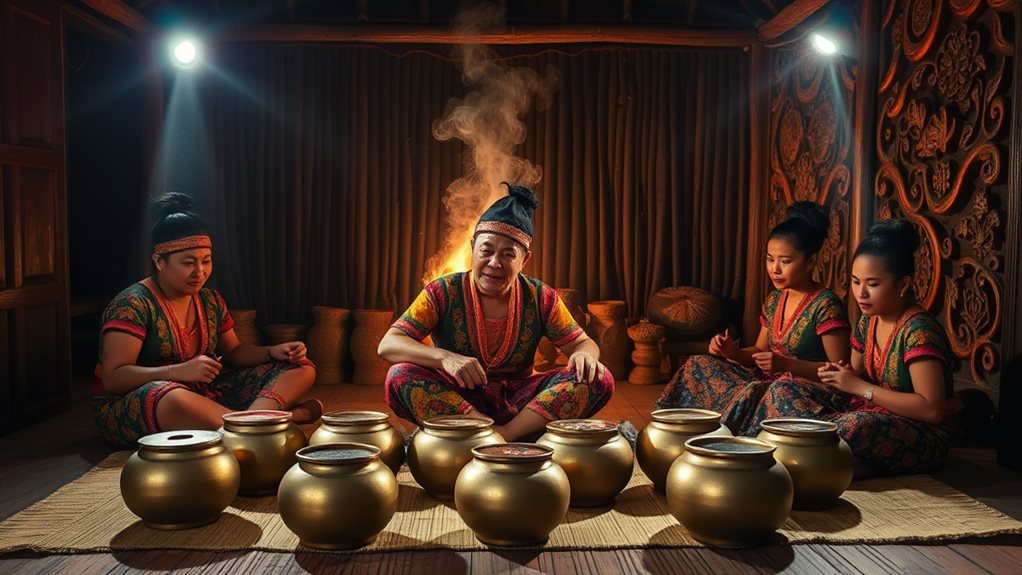
Florante Aguilar's Utom is a musical composition comprising eight movements that narrate the legend of Lake Sebu, integral to Tboli culture and identity.
Utom movements analysis reveals a structured yet flexible framework, where each segment builds on the narrative complexity of the preceding ones. The composition employs Tboli narrative techniques, blending oral storytelling traditions with musical expression to convey spiritual and historical messages.
Instruments such as the kulintang and agung are central, resonating with themes of nature and spirituality. Aguilar's arrangement allows for contemporary interpretations, enabling non-traditional musicians to engage with the kulintang, merging traditional Tboli influences with modern musical forms.
Performance enhancements include short film footage, adding a visual dimension that enriches the audience's engagement with Tboli culture.
Questions and Answers
What Traditional Musical Instrument Was Popularized by the T Boli Tribe?
You explored the traditional musical instruments of the Tboli tribe, emphasizing the kulintang's cultural significance and role in music festivals.
What Is the Tradition of Tboli?
The Current Question addresses Tboli rituals, cultural significance, community gatherings, highlighting shared traditions fostering unity, oral literature, and spiritual connections within Tboli society.
What Is Mo Ninum?
Mo ninum significance lies in greeting and welcoming visitors. Its performance showcases rich vocal traditions. Symbolism includes unity, friendship, community values.
What Is the Most Famous Art of the T Boli Tribe?
The most famous art of the Tboli tribe is Tboli weaving, producing intricate Tnalak fabric, reflecting Tboli rituals, storytelling, and cultural significance through vibrant patterns and spiritual inspiration.